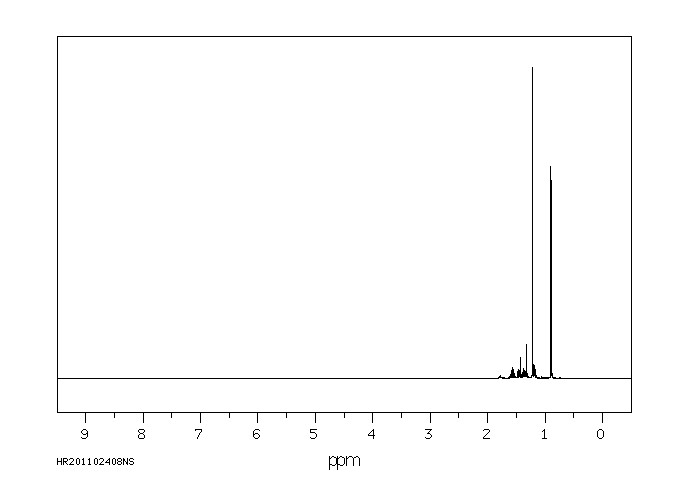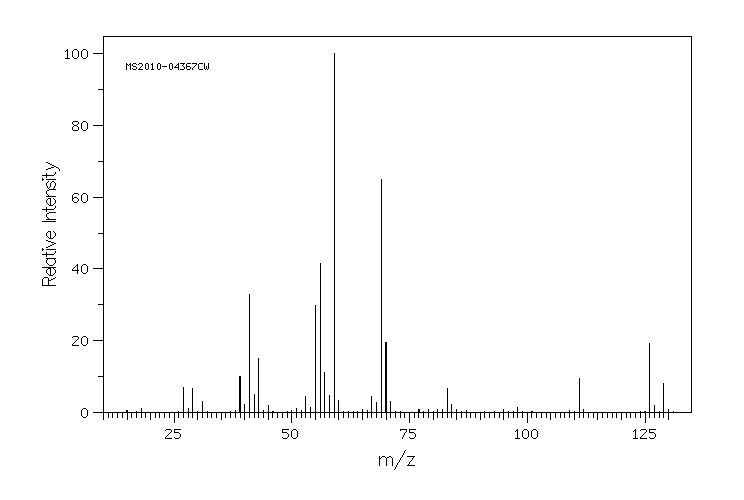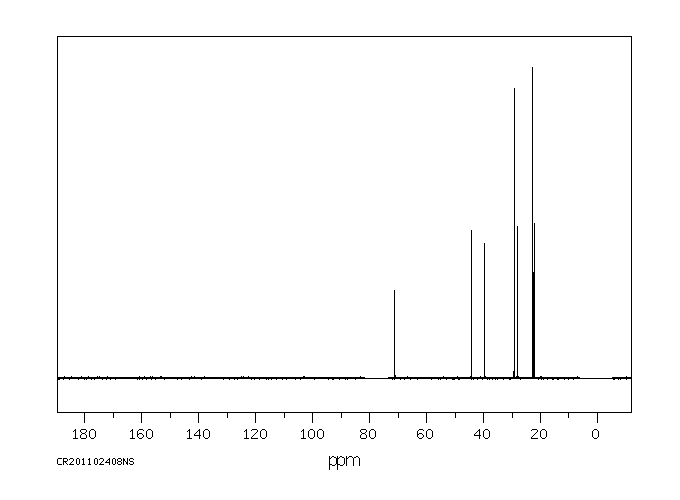2,6-二甲基-2-庚醇 | 13254-34-7
中文名称
2,6-二甲基-2-庚醇
中文别名
2,6-二甲基庚醇;2,6-二甲基庚基-2-醇
英文名称
2,6-dimethylheptan-2-ol
英文别名
2,6-dimethyl-heptane-2-ol;2-heptanol, 2,6-dimethyl-;2,6-Dimethyl-2-heptanol;dimetol;2,6-dimethyl-heptan-2-ol;Dimethylisohexylcarbinol
CAS
13254-34-7
化学式
C9H20O
mdl
——
分子量
144.257
InChiKey
HGDVHRITTGWMJK-UHFFFAOYSA-N
BEILSTEIN
——
EINECS
——
-
物化性质
-
计算性质
-
ADMET
-
安全信息
-
SDS
-
制备方法与用途
-
上下游信息
-
文献信息
-
表征谱图
-
同类化合物
-
相关功能分类
-
相关结构分类
物化性质
-
熔点:-10 °C
-
沸点:180 °C
-
密度:0.81
-
闪点:63 °C
-
LogP:3
-
保留指数:1023
-
稳定性/保质期:
在常温常压下保持稳定,应避免与氧化物接触。
计算性质
-
辛醇/水分配系数(LogP):2.7
-
重原子数:10
-
可旋转键数:4
-
环数:0.0
-
sp3杂化的碳原子比例:1.0
-
拓扑面积:20.2
-
氢给体数:1
-
氢受体数:1
安全信息
-
TSCA:Yes
-
安全说明:S24/25
-
危险类别码:R41
-
RTECS号:MJ3324950
-
海关编码:2906199090
-
危险性防范说明:P210,P305+P351+P338
-
危险性描述:H227,H315,H319
SDS
| Name: | 2 6-Dimethyl-2-heptanol 99% Material Safety Data Sheet |
| Synonym: | Dimetol |
| CAS: | 13254-34-7 |
Synonym:Dimetol
Section 2 - COMPOSITION, INFORMATION ON INGREDIENTS
| CAS# | Chemical Name | content | EINECS# |
| 13254-34-7 | 2-Heptanol, 2,6-dimethyl- | 99 | 236-244-1 |
Risk Phrases: 36/37/38
Section 3 - HAZARDS IDENTIFICATION
EMERGENCY OVERVIEW
Irritating to eyes, respiratory system and skin.
Potential Health Effects
Eye:
Causes eye irritation. May cause chemical conjunctivitis and corneal damage.
Skin:
Causes skin irritation. May cause cyanosis of the extremities.
Ingestion:
May cause gastrointestinal irritation with nausea, vomiting and diarrhea.
Inhalation:
Causes respiratory tract irritation. Aspiration may lead to pulmonary edema. Can produce delayed pulmonary edema. Inhalation at high concentrations may cause CNS depression and asphixiation.
Chronic:
Effects may be delayed.
Section 4 - FIRST AID MEASURES
Eyes: Immediately flush eyes with plenty of water for at least 15 minutes, occasionally lifting the upper and lower eyelids. Get medical aid.
Skin:
Get medical aid. Flush skin with plenty of water for at least 15 minutes while removing contaminated clothing and shoes. Wash clothing before reuse.
Ingestion:
Never give anything by mouth to an unconscious person. Get medical aid. Do NOT induce vomiting. If conscious and alert, rinse mouth and drink 2-4 cupfuls of milk or water.
Inhalation:
Remove from exposure and move to fresh air immediately. If not breathing, give artificial respiration. If breathing is difficult, give oxygen. Get medical aid. Do NOT use mouth-to-mouth resuscitation.
Notes to Physician:
Treat symptomatically and supportively.
Section 5 - FIRE FIGHTING MEASURES
General Information:
As in any fire, wear a self-contained breathing apparatus in pressure-demand, MSHA/NIOSH (approved or equivalent), and full protective gear. During a fire, irritating and highly toxic gases may be generated by thermal decomposition or combustion. Use water spray to keep fire-exposed containers cool. Water may be ineffective.
Material is lighter than water and a fire may be spread by the use of water. Combustible liquid. Vapors may be heavier than air. They can spread along the ground and collect in low or confined areas.
Containers may explode when heated.
Extinguishing Media:
In case of fire, use water, dry chemical, chemical foam, or alcohol-resistant foam. Use water spray to cool fire-exposed containers. Water may be ineffective.
Section 6 - ACCIDENTAL RELEASE MEASURES
General Information: Use proper personal protective equipment as indicated in Section 8.
Spills/Leaks:
Absorb spill with inert material (e.g. vermiculite, sand or earth), then place in suitable container. Avoid runoff into storm sewers and ditches which lead to waterways. Clean up spills immediately, observing precautions in the Protective Equipment section. Remove all sources of ignition. Use a spark-proof tool. Provide ventilation.
Section 7 - HANDLING and STORAGE
Handling:
Wash thoroughly after handling. Remove contaminated clothing and wash before reuse. Use with adequate ventilation. Avoid contact with eyes, skin, and clothing. Empty containers retain product residue, (liquid and/or vapor), and can be dangerous. Keep container tightly closed. Keep away from heat, sparks and flame. Avoid ingestion and inhalation. Do not pressurize, cut, weld, braze, solder, drill, grind, or expose empty containers to heat, sparks or open flames.
Storage:
Keep away from heat, sparks, and flame. Keep away from sources of ignition. Store in a tightly closed container. Store in a cool, dry, well-ventilated area away from incompatible substances.
Section 8 - EXPOSURE CONTROLS, PERSONAL PROTECTION
Engineering Controls:
Facilities storing or utilizing this material should be equipped with an eyewash facility and a safety shower. Use adequate ventilation to keep airborne concentrations low.
Exposure Limits CAS# 13254-34-7: Personal Protective Equipment Eyes: Wear appropriate protective eyeglasses or chemical safety goggles as described by OSHA's eye and face protection regulations in 29 CFR 1910.133 or European Standard EN166.
Skin:
Wear appropriate protective gloves to prevent skin exposure.
Clothing:
Wear appropriate protective clothing to prevent skin exposure.
Respirators:
A respiratory protection program that meets OSHA's 29 CFR 1910.134 and ANSI Z88.2 requirements or European Standard EN 149 must be followed whenever workplace conditions warrant respirator use.
Section 9 - PHYSICAL AND CHEMICAL PROPERTIES
Physical State: Liquid
Color: clear, colorless
Odor: alcohol-like
pH: Not available.
Vapor Pressure: Not available.
Viscosity: Not available.
Boiling Point: 180 deg C
Freezing/Melting Point: -10 deg C
Autoignition Temperature: Not available.
Flash Point: 63 deg C ( 145.40 deg F)
Explosion Limits, lower: Not available.
Explosion Limits, upper: Not available.
Decomposition Temperature:
Solubility in water: slightly soluble
Specific Gravity/Density: .8120g/cm3
Molecular Formula: C9H20O
Molecular Weight: 144.26
Section 10 - STABILITY AND REACTIVITY
Chemical Stability:
Stable at room temperature in closed containers under normal storage and handling conditions.
Conditions to Avoid:
Incompatible materials, ignition sources, excess heat, strong oxidants.
Incompatibilities with Other Materials:
Strong oxidizing agents.
Hazardous Decomposition Products:
Carbon monoxide, irritating and toxic fumes and gases, carbon dioxide.
Hazardous Polymerization: Has not been reported
Section 11 - TOXICOLOGICAL INFORMATION
RTECS#:
CAS# 13254-34-7: MJ3324950 LD50/LC50:
CAS# 13254-34-7: Draize test, rabbit, eye: 100 mg Severe; Draize test, rabbit, skin: 500 mg Severe; Oral, rat: LD50 = 6800 mg/kg; Skin, rabbit: LD50 = >5 gm/kg.
Carcinogenicity:
2-Heptanol, 2,6-dimethyl- - Not listed by ACGIH, IARC, or NTP.
Other:
See actual entry in RTECS for complete information.
Section 12 - ECOLOGICAL INFORMATION
Section 13 - DISPOSAL CONSIDERATIONS
Dispose of in a manner consistent with federal, state, and local regulations.
Section 14 - TRANSPORT INFORMATION
IATA
Not regulated as a hazardous material.
IMO
Not regulated as a hazardous material.
RID/ADR
Not regulated as a hazardous material.
Section 15 - REGULATORY INFORMATION
European/International Regulations
European Labeling in Accordance with EC Directives
Hazard Symbols: XI
Risk Phrases:
R 36/37/38 Irritating to eyes, respiratory system
and skin.
Safety Phrases:
S 24/25 Avoid contact with skin and eyes.
S 28A After contact with skin, wash immediately with
plenty of water.
S 37 Wear suitable gloves.
S 45 In case of accident or if you feel unwell, seek
medical advice immediately (show the label where
possible).
WGK (Water Danger/Protection)
CAS# 13254-34-7: 1
Canada
CAS# 13254-34-7 is listed on Canada's DSL List.
CAS# 13254-34-7 is not listed on Canada's Ingredient Disclosure List.
US FEDERAL
TSCA
CAS# 13254-34-7 is listed on the TSCA inventory.
SECTION 16 - ADDITIONAL INFORMATION
N/A
制备方法与用途
类别:易燃液体
毒性分级:低毒
急性毒性(口服):大鼠 LD50 为 6800 毫克/公斤
刺激数据:皮肤(兔子,500 毫克)重度;眼睛(兔子,100 毫克)重度
可燃性危险特性:遇明火、高温或强氧化剂可燃;燃烧时会排放刺激烟雾
储运特性:包装完整且轻装轻卸;库房需通风良好,并远离明火、高温及氧化剂
灭火剂:泡沫、干粉、二氧化碳或砂土
反应信息
-
作为反应物:描述:2,6-二甲基-2-庚醇 在 tris(pentafluorophenyl)borane hydrate 、 二乙胺基三氟化硫 作用下, 以 硝基甲烷 、 二氯甲烷 为溶剂, 反应 1.0h, 生成 2,6-dimethylhept-2-yl phenyl sulfide参考文献:名称:催化脂肪族氟化物B(C 6 F 5)3 H 2 O促进的脱氟官能化摘要:描述了在良性反应条件下进行的AB(C 6 F 5)3 H 2 O催化的叔脂肪族氟化物的脱氟官能化。通过快速有效地形成一系列具有新安装的C(sp 3)N,S,C和O键的产品,可以举例说明该方法的综合用途。这项研究说明了其他惰性原料的广泛反应性,并提供了通往有价值的和合成上代表性不足的产品的途径,这些产品以前从未从此类氟化前体中获得。DOI:10.1016/j.jfluchem.2016.11.005
-
作为产物:描述:(4R)-2,4,8-trimethylnon-2-ene 生成 2,6-二甲基-2-庚醇参考文献:名称:VOGEL, F.;PAUST, J.摘要:DOI:
文献信息
-
Dual nickel- and photoredox-catalyzed reductive cross-coupling of aryl vinyl halides and unactivated tertiary alkyl bromides作者:Weijie Yu、Long Chen、Jiasi Tao、Tao Wang、Junkai FuDOI:10.1039/c9cc00768g日期:——A novel reductive cross-coupling of aryl vinyl halides and unactivated tertiary alkyl bromides has been realized via photoredox/nickel dual catalysis to produce vinyl arene derivatives bearing all-carbon quaternary centers with excellent E-selectivity. A stoichiometric metal reductant could be avoided by employing commercially available N,N,N′,N′-tetramethylethylenediamine (TMEDA) as the terminal reductant
-
3-Desoxy-2-Methylene-Vitamin D Analogs and Their Uses申请人:WISCONSIN ALUMNI RESEARCH FOUNDATION公开号:US20130102567A1公开(公告)日:2013-04-25This invention discloses 3-desoxy-2-methylene-vitamin D analogs, and specifically (20S)-3-desoxy-1α,25-dihydroxy-2-methylene-vitamin D 3 and (20R)-3-desoxy-1α, 25-dihydroxy-2-methylene-vitamin D 3 as well as pharmaceutical uses therefor. These compounds exhibit relatively high binding activity and pronounced activity in arresting the proliferation of undifferentiated cells and inducing their differentiation to monocytes thus evidencing use as anti-cancer agents especially for the treatment or prevention of osteosarcoma, leukemia, colon cancer, breast cancer, skin cancer or prostate cancer. These compounds also exhibit relatively high calcemic activity evidencing use in the treatment of bone diseases.
-
Synthese von geminal methylierten 4-Chlorbutylaminen
-
Cosmetic compositions申请人:Symrise AG公开号:EP2745878A1公开(公告)日:2014-06-25Suggested is a cosmetic compositions comprising (a) a crosspolymer obtained from copolymerisation of at least two different polyols and at least one dicarboxylic acid and (b) at least one fragrance.
-
Acylation of 2,2,6,6-tetramethylpiperidine and 2,2,5,5-tetramethylpyrrolidine作者:S. S. Berg、D. T. CowlingDOI:10.1039/j39710001653日期:——Treatment of 2,2,6,6-tetramethylpiperidine with carbonyl dichloride caused ring fission with loss of hydrogen chloride to give a mixture of 1,1,5-trimethylhex-4-enyl isocyanate and 1,1,5-trimethylhex-5-enyl isocyanate which on treatment with sodium carbonate gave N-(1,1,5-trimethylhex-4-enyl)-N′-(1,1,5-trimethylhex-5-enyl)urea. Ring fission also occurred on treatment with acetic anhydride or acetyl用二氯化碳处理2,2,6,6-四甲基哌啶引起环裂变,并损失氯化氢,得到1,1,5-三甲基己-4-烯基异氰酸酯和1,1,5-三甲基己-5-的混合物碳酸钠处理后的异氰酸烯基酯,可得到N-(1,1,5-三甲基己-4-烯基)-N' -(1,1,5-三甲基己-5-烯基)脲。在用乙酸酐或乙酰氯处理时,也会发生环裂变,生成N-(1,1,5-三甲基己-4-烯基)乙酰胺和N的混合物-(1,1,5-三甲基己-5-烯基)乙酰胺,尽管条件可以改变以得到1-乙酰基-2,2,6,6-四甲基哌啶。用二氯化羰基处理2,2,5,5-四甲基吡咯烷产生1-氯羰基衍生物,其通常与醇和胺反应。
表征谱图
-
氢谱1HNMR
-
质谱MS
-
碳谱13CNMR
-
红外IR
-
拉曼Raman
-
峰位数据
-
峰位匹配
-
表征信息
同类化合物
(反式)-4-壬烯醛
(s)-2,3-二羟基丙酸甲酯
([1-(甲氧基甲基)-1H-1,2,4-三唑-5-基](苯基)甲酮)
(Z)-4-辛烯醛
(S)-氨基甲酸酯β-D-O-葡糖醛酸
(S)-3-(((2,2-二氟-1-羟基-7-(甲基磺酰基)-2,3-二氢-1H-茚满-4-基)氧基)-5-氟苄腈
(R)-氨基甲酸酯β-D-O-葡糖醛酸
(5,5-二甲基-2-(哌啶-2-基)环己烷-1,3-二酮)
(2,5-二氟苯基)-4-哌啶基-甲酮
龙胆苦苷
龙胆二糖甲乙酮氰醇(P)
龙胆二糖丙酮氰醇(P)
龙胆三糖
龙涎酮
齐罗硅酮
齐留通beta-D-葡糖苷酸
鼠李糖
黑芥子苷单钾盐
黑海棉酸钠盐
黑木金合欢素
黑曲霉三糖
黑介子苷
黄尿酸8-O-葡糖苷
麻西那霉素II
麦迪霉素
麦芽糖脎
麦芽糖基海藻糖
麦芽糖1-磷酸酯
麦芽糖
麦芽四糖醇
麦芽四糖
麦芽十糖
麦芽六糖
麦芽五糖水合物
麦芽五糖
麦芽五糖
麦芽五糖
麦芽三糖醇
麦芽三糖
麦芽三糖
麦芽三塘水合
麦芽七糖水合物
麦芽七糖
麦法朵
麦可酚酸-酰基-Β-D-葡糖苷酸
麦利查咪
麝香酮
鹤草酚
鸢尾酚酮 3-C-beta-D-吡喃葡萄糖苷
鸡矢藤苷










